人教版七年级英语下第九、十单元知识重点
- 格式:doc
- 大小:37.50 KB
- 文档页数:3
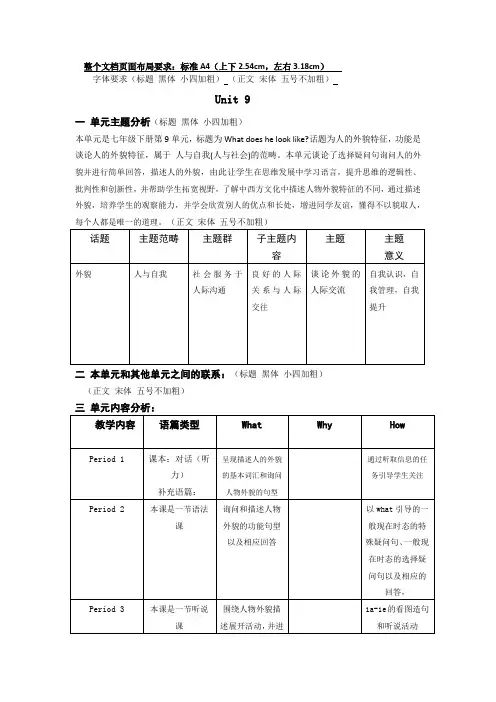
整个文档页面布局要求:标准A4(上下2.54cm,左右3.18cm)字体要求(标题黑体小四加粗)(正文宋体五号不加粗)Unit 9一单元主题分析(标题黑体小四加粗)本单元是七年级下册第9单元,标题为What does he look like?话题为人的外貌特征,功能是谈论人的外貌特征,属于人与自我(人与社会)的范畴。
本单元谈论了选择疑问句询问人的外貌并进行简单回答,描述人的外貌,由此让学生在思维发展中学习语言,提升思维的逻辑性、批判性和创新性,并帮助学生拓宽视野,了解中西方文化中描述人物外貌特征的不同,通过描述外貌,培养学生的观察能力,并学会欣赏别人的优点和长处,增进同学友谊,懂得不以貌取人,每个人都是唯一的道理二本单元和其他单元之间的联系:(标题黑体小四加粗)(正文宋体五号不加粗)四单元教学目标:本单元学习内容贴近学生的日常生活,主题是描述一个人的外貌,极易激发学生学习英语的欲望和兴趣,能够使学生有话可说,乐于参与各种英语实践活动。
在之前的学习中,学生已掌握了主系表结构和主谓宾结构的不同句式,为本单元准确描述自己和他人的身高体型、身体部位特征、穿着打扮等方面打下了一定的基础。
同时,学生之前已掌握少部分与此话题相关的词汇,为本单元教学活动的顺利开展积累了一定的语料。
教师在课堂设计时应由旧知引新知,发挥优势,设计有趣的课堂任务引导学生进行自主学习和语言实践,渗透学法指导并引导学生逐步养成良好的英语学习习惯。
整个文档页面布局要求:标准A4(上下2.54cm,左右3.18cm)字体要求(标题黑体小四加粗)(正文宋体五号不加粗)Unit 10一单元主题分析(标题黑体小四加粗)本单元是七年级下册第10单元,标题为I’d like some noodles话题为食物,功能是谈论各种食物名称和点餐的基本表达,属于人与自我(人与社会)的范畴。
本单元谈论了饮食话题与学生的生活息息相关,由此让学生了解如何用英语表达中国传统食物和菜肴,加深对中国文化的理解,坚定文化自信,同时懂得珍惜粮食,提高人文素养。
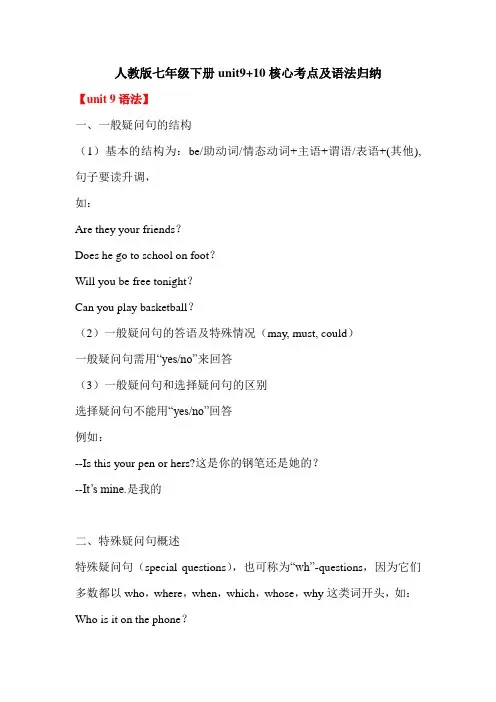
人教版七年级下册unit9+10核心考点及语法归纳【unit 9语法】一、一般疑问句的结构(1)基本的结构为:be/助动词/情态动词+主语+谓语/表语+(其他),句子要读升调,如:Are they your friends?Does he go to school on foot?Will you be free tonight?Can you play basketball?(2)一般疑问句的答语及特殊情况(may, must, could)一般疑问句需用“yes/no”来回答(3)一般疑问句和选择疑问句的区别选择疑问句不能用“yes/no”回答例如:--Is this your pen or hers?这是你的钢笔还是她的?--It’s mine.是我的二、特殊疑问句概述特殊疑问句(special questions),也可称为“wh”-questions,因为它们多数都以who,where,when,which,whose,why这类词开头,如:Who is it on the phone?How many oranges can you see in the picture?Where did you last see it?What did you eat yesterday?How do you usually go to school?Why didn’t you tell me?它的结构一般为:特殊疑问词+一般疑问句,即:特殊疑问词+be/助动词/情态动词+主语+谓语/表语+(其他),如:who,whom,which,what,whose五个疑问代词when,where,why,how及how与其他副词和形容词组成的疑问副词what time, how long, how soon, how often, how old, how far, how many, how much【unit 9重点句子】He has brown hair and wears glasses.他留着棕色头发,戴着眼镜。
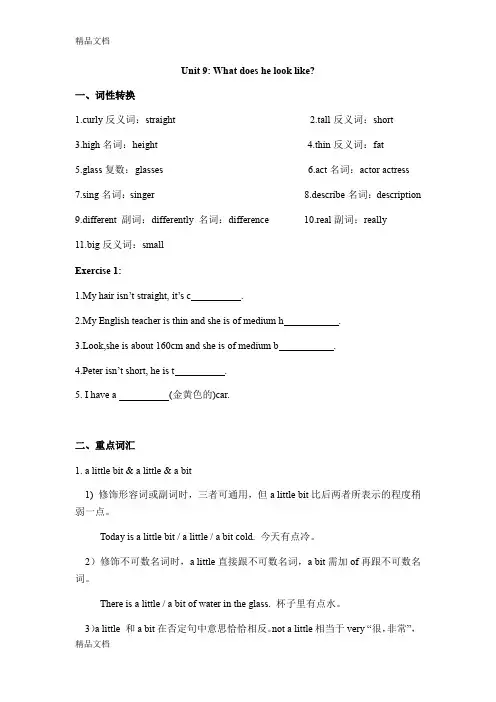
Unit 9: What does he look like?一、词性转换1.curly反义词:straight2.tall反义词:short3.high名词:height4.thin反义词:fat5.glass复数:glasses6.act名词:actor actress7.sing名词:singer 8.describe名词:description9.different 副词:differently 名词:difference 10.real副词:really11.big反义词:smallExercise 1:二、重点词汇1. a little bit & a little & a bit1) 修饰形容词或副词时,三者可通用,但a little bit比后两者所表示的程度稍弱一点。
Today is a little bit / a little / a bit cold. 今天有点冷。
2)修饰不可数名词时,a little直接跟不可数名词,a bit需加of再跟不可数名词。
There is a little / a bit of water in the glass. 杯子里有点水。
3)a little 和a bit在否定句中意思恰恰相反。
not a little相当于very “很,非常”,not a bit相当于not….at all“一点也不”。
① He is not a little hungry. = He is very hungry. 他很饿。
② He is not a bit hungry. = He isn’t hungry at all. 他一点也不饿。
2. stop to do sth. “停下来去做某事”。
指停止原来做的事情,去做另一件事情。
stop doing sth. “停止做某事”,指停止正在做的事情,即不做某事了。
E.g. He stops to do his homework.He stops doing his homework.Class begins, please stop talking.We are all tired, stop to have a rest.3. remember/forget doing sth. 记得/忘记做过某事(事情已做)remember/forget to do sth. 记得/忘记要去做某事(事情还没做)E.g. Please remember to eat lunch.I am sorry, I forget to my homework.I remember playing computer with my sister yesterday.I forget calling you.4. no more & not….any more & no longer & not….any longer1) no more = not….any more表示数量和程度的“不再(增加)”,常修饰终止性动词。
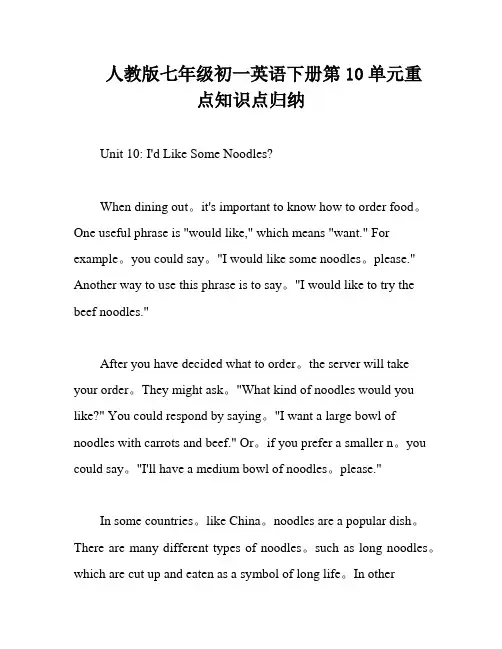
人教版七年级初一英语下册第10单元重点知识点归纳Unit 10: I'd Like Some Noodles?When dining out。
it's important to know how to order food。
One useful phrase is "would like," which means "want." For example。
you could say。
"I would like some noodles。
please." Another way to use this phrase is to say。
"I would like to try the beef noodles."After you have decided what to order。
the server will take your order。
They might ask。
"What kind of noodles would you like?" You could respond by saying。
"I want a large bowl of noodles with carrots and beef." Or。
if you prefer a smaller n。
you could say。
"I'll have a medium bowl of noodles。
please."In some countries。
like China。
noodles are a popular dish。
There are many different types of noodles。
such as long noodles。
which are cut up and eaten as a symbol of long life。
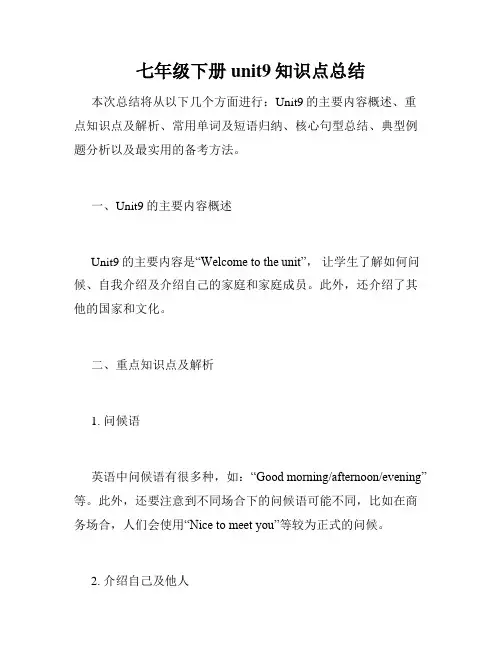
七年级下册unit9知识点总结本次总结将从以下几个方面进行:Unit9的主要内容概述、重点知识点及解析、常用单词及短语归纳、核心句型总结、典型例题分析以及最实用的备考方法。
一、Unit9的主要内容概述Unit9的主要内容是“Welcome to the unit”,让学生了解如何问候、自我介绍及介绍自己的家庭和家庭成员。
此外,还介绍了其他的国家和文化。
二、重点知识点及解析1. 问候语英语中问候语有很多种,如:“Good morning/afternoon/evening”等。
此外,还要注意到不同场合下的问候语可能不同,比如在商务场合,人们会使用“Nice to meet you”等较为正式的问候。
2. 介绍自己及他人在介绍自己时,需要注意到自己的年龄、职业、家乡等方面。
在介绍他人时,需要清楚地表达被介绍人的姓名、职业等信息,并且要使用正确的代词。
3.国家和文化学习一个国家的文化不仅是对该国家的了解,还可以更好地加深双方的友谊。
在学习一个国家的文化时,需要了解一些基本事实,如人口、宗教、风俗等。
4. 描述家庭及家庭成员描述家庭及家庭成员时,注意到正确使用主谓宾结构,需要描述家庭的人物关系及他们的特点,如人物的性格、爱好等。
三、常用单词及短语归纳1.问候语:good morning/ afternoon/ evening2.自我介绍:My name is... /I'm from...3.介绍他人:This is... /He/She is…/ His/Her name is...4.国家和文化:America/ Chinese/ culture/ tradition5. 描述家庭及家庭成员:sister/ brother/ father/ mother四、核心句型总结1. What’s your name?2. Where are you from?3. How old are you?4. Nice to meet you.5. This is my... He/She is from...五、典型例题分析1. -- ________ are you, John? -- I’m twelve.A. How manyB. How muchC. How old答案:C2. -- Is this your brother? -- ___________.A. Yes, he is.B. No, he isn’t.C. Yes, he isn’t.D. No, he is.答案:A3. -- Where are you from? -- ________.A. Good morningB. Nice to meet youC. I'm from ChinaD. Thank you答案:C六、最实用的备考方法1. 多听多读多说。
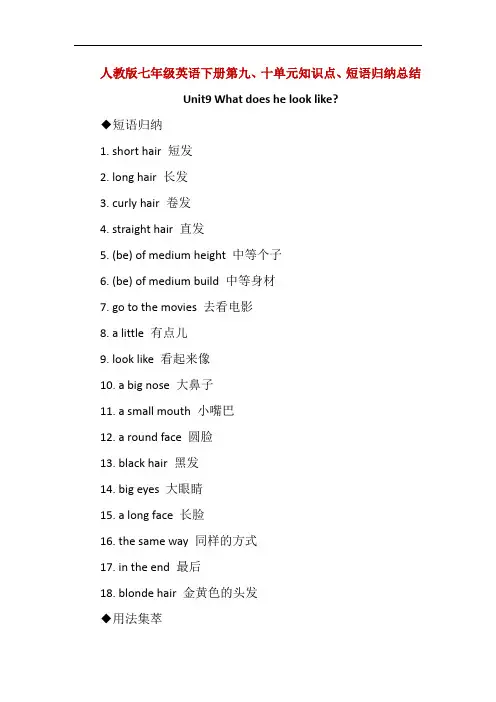
人教版七年级英语下册第九、十单元知识点、短语归纳总结Unit9 What does he look like?◆短语归纳1. short hair 短发2. long hair 长发3. curly hair 卷发4. straight hair 直发5. (be) of medium height 中等个子6. (be) of medium build 中等身材7. go to the movies 去看电影8. a little 有点儿9. look like 看起来像10. a big nose 大鼻子11. a small mouth 小嘴巴12. a round face 圆脸13. black hair 黑发14. big eyes 大眼睛15. a long face 长脸16. the same way 同样的方式17. in the end 最后18. blonde hair 金黄色的头发◆用法集萃1. What does / do + 主语+ look like? ……长得什么样?2. sb. + be + of + medium build / height 某人中等身材/个子3. sb. + has +…hair 某人留着……头发4. sb. wears + ... 某人穿着/戴着……◆典句必背1. —What does he look like? 他长什么样?—He’s really tall. 他真的很高。
2. —Do they have straight or curly hair? 他们留直发还是卷发?—They have curly hair. 他们留卷发。
3. —Is he tall or short? 他高还是矮?—He isn’t tall or short. He’s of medium height. 他不高不矮。
他中等个子。
4. The man with a pair of glasses is my English teacher. 那个戴眼镜的男人是我的英语老师。
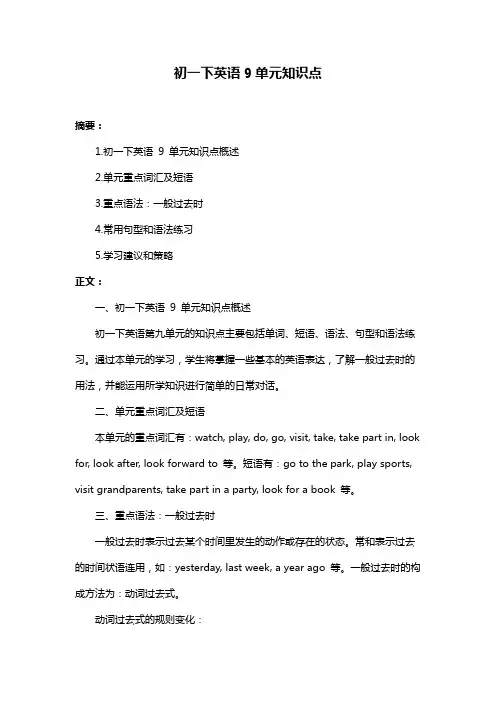
初一下英语9单元知识点摘要:1.初一下英语9 单元知识点概述2.单元重点词汇及短语3.重点语法:一般过去时4.常用句型和语法练习5.学习建议和策略正文:一、初一下英语9 单元知识点概述初一下英语第九单元的知识点主要包括单词、短语、语法、句型和语法练习。
通过本单元的学习,学生将掌握一些基本的英语表达,了解一般过去时的用法,并能运用所学知识进行简单的日常对话。
二、单元重点词汇及短语本单元的重点词汇有:watch, play, do, go, visit, take, take part in, look for, look after, look forward to 等。
短语有:go to the park, play sports, visit grandparents, take part in a party, look for a book 等。
三、重点语法:一般过去时一般过去时表示过去某个时间里发生的动作或存在的状态。
常和表示过去的时间状语连用,如:yesterday, last week, a year ago 等。
一般过去时的构成方法为:动词过去式。
动词过去式的规则变化:1.一般情况下,动词词尾加-ed。
2.以e 结尾的动词,加-d。
3.以辅音字母加y 结尾的动词,变y 为i,再加-ed。
4.少数不规则动词需单独记忆。
四、常用句型和语法练习1.询问过去发生的事情:- What did you do yesterday?- I played basketball with my friends.2.描述过去发生的事情:- I watched a movie last night.- We visited my grandparents last weekend.3.表达过去习惯性的动作:- I used to go to the park every morning.- She always took her lunch to school.4.一般过去时与现在时的对比:- He is playing soccer now.(现在进行时)- He played soccer yesterday.(一般过去时)五、学习建议和策略1.加强词汇记忆,通过不断重复和运用,提高词汇量。
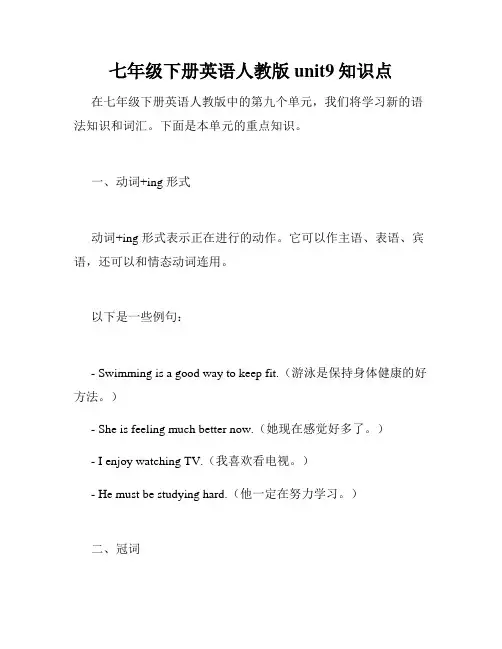
七年级下册英语人教版unit9知识点在七年级下册英语人教版中的第九个单元,我们将学习新的语法知识和词汇。
下面是本单元的重点知识。
一、动词+ing 形式动词+ing 形式表示正在进行的动作。
它可以作主语、表语、宾语,还可以和情态动词连用。
以下是一些例句:- Swimming is a good way to keep fit.(游泳是保持身体健康的好方法。
)- She is feeling much better now.(她现在感觉好多了。
)- I enjoy watching TV.(我喜欢看电视。
)- He must be studying hard.(他一定在努力学习。
)二、冠词冠词分为定冠词和不定冠词。
定冠词表示特定的一个或一组事物,不定冠词表示任何一个或一组事物。
以下是一些例句:- The book on the desk is mine.(桌子上的那本书是我的。
)- A cat is sleeping on the sofa.(有一只猫在沙发上睡觉。
)- I have a headache.(我头疼。
)三、数词数词用来表示数量。
它们可以是基数词(表示数量的词),也可以是序数词(表示顺序的词)。
以下是一些例句:- There are three apples on the table.(桌子上有三个苹果。
)- This is the first time I've been to Beijing.(这是我第一次去北京。
)- The concert is on June 6th.(音乐会在6月6日举行。
)四、情态动词情态动词用来表示说话者对某种行为或状态的看法。
它们包括can、could、may、might、shall、should、will、would、must 等。
以下是一些例句:- You can come to my party if you want.(如果你愿意,你可以来参加我的聚会。
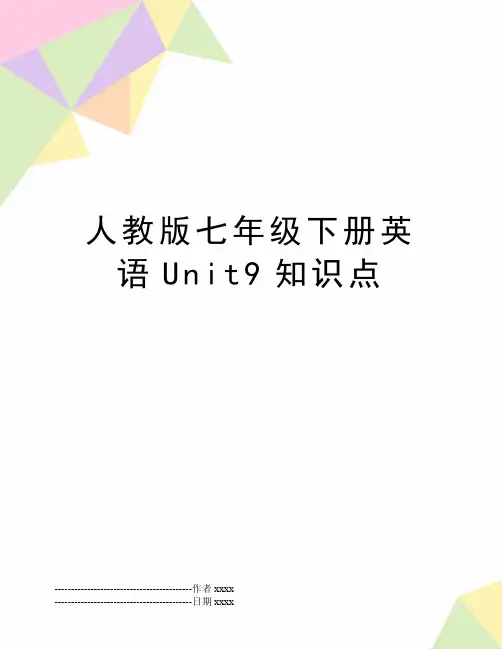
人教版七年级下册英语U n i t9知识点------------------------------------------作者xxxx------------------------------------------日期xxxxUnit9 名词:height 身高;高度cinema 电影院glasses 眼镜actor 演员actress女演员person 人nose 鼻子mouth 嘴face 脸eye眼睛singer 歌手artist 艺术家way方式;路线end 结尾;尽头动词:may 也许;可能;可以put 放describe 描述形容词:straight 直的curly 卷曲的tall高的thin 瘦的heavy 重的little 小的medium 中等的handsome英俊的round 圆形的real 真正的;真实的副词:later 以后differently 不同地兼类词:tonight adv&n(在)今晚;(在)今夜each adj&pron 每个;各自another adj&pron另一;又一短语:(be)of medium height 中等身高a little 一点;少量look like 看起来像first of all 首先in the end最后知识点:1、tall 高的反义词 short矮的,常指人、动物、树、建筑物等很高a tall tree一棵高高的树a tall building 一栋高楼high 高的反义词low 低的,多指山高,也指空间位置或程度高,还可以指价格、速度、温度等a high mountain一座高山high price 价格高2、medium 中等的be of medium height 中等身高be of medium build 中等身材My uncle is of medium height。
我叔叔中等身高.区分:middle 中间的;中部的There is a tree in themiddle of hisyard. 他的院子中央有一棵树。
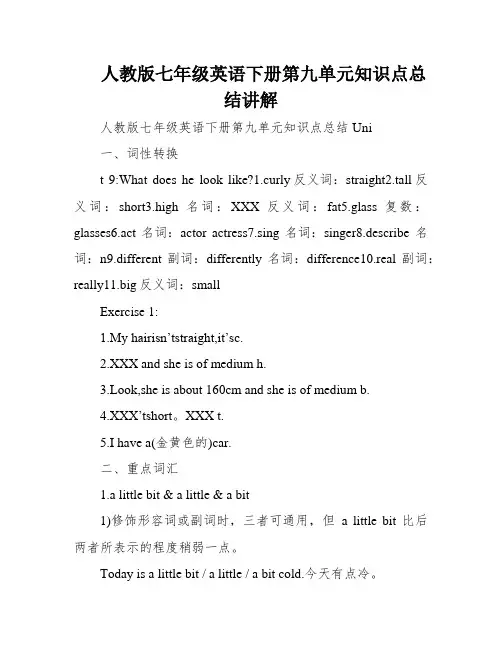
人教版七年级英语下册第九单元知识点总结讲解人教版七年级英语下册第九单元知识点总结Uni一、词性转换t 9:What does he look like?1.curly反义词:straight2.tall反义词:short3.high名词:XXX反义词:fat5.glass复数:glasses6.act名词:actor actress7.sing名词:singer8.describe名词:n9.different副词:differently名词:difference10.real副词:really11.big反义词:smallExercise 1:1.My hairisn’tstraight,it’sc.2.XXX and she is of medium h.3.Look,she is about 160cm and she is of medium b.4.XXX’tshort。
XXX t.5.I have a(金黄色的)car.二、重点词汇1.a little bit & a little & a bit1)修饰形容词或副词时,三者可通用,但a little bit比后两者所表示的程度稍弱一点。
Today is a little bit / a little / a bit cold.今天有点冷。
2)润饰不成数名词时,a little间接跟不成数名词,a bit 需加of再跟不成数名词。
There is a little / a bit of water in the glass.杯子里有点水。
3)a little和a bit在否定句中意义恰好相反。
not a little相当于very “很,十分”,not a bit相当于not….at all“一点也不”。
①He is not a little hungry。
= He is very hungry.他很饿。
②He is not a bit hungry。
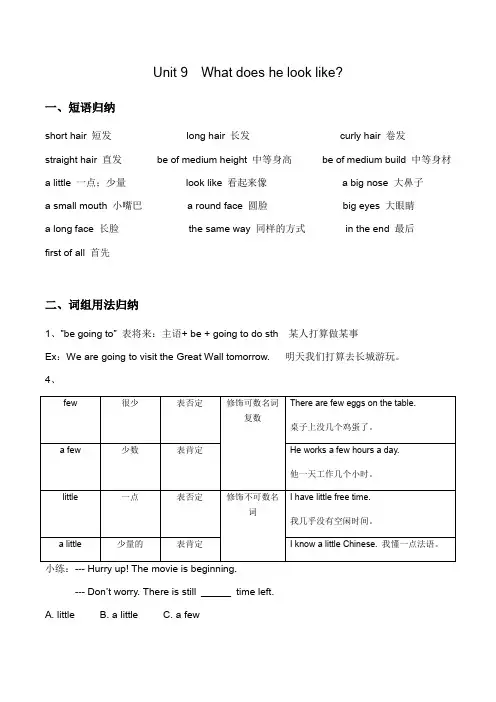
Unit 9 What does he look like?一、短语归纳short hair 短发long hair 长发curly hair 卷发straight hair 直发be of medium height 中等身高be of medium build 中等身材a little 一点;少量look like 看起来像 a big nose 大鼻子a small mouth 小嘴巴 a round face 圆脸big eyes 大眼睛a long face 长脸the same way 同样的方式in the end 最后first of all 首先二、词组用法归纳1、”be going to” 表将来:主语+ be + going to do sth 某人打算做某事Ex:We are going to visit the Great Wall tomorrow. 明天我们打算去长城游玩。
4、小练:--- Hurry up! The movie is beginning.--- Don’t worry. There is still time left.A. littleB. a littleC. a few5、each:做形容词时,修饰可数名词单数,意为“每个;各自”Ex:Each school has its own library. 每一所学校都有它自己的图书馆。
三、语法归纳(一)询问及描述外貌:1、询问外貌:What do/ does sb look like? 某人长什么样?2、描述人的外貌的句型如下:(1)表示某人的个头或身材:主语+ be of +形容词+ height/ build.Ex:Our math teacher is of medium build. 我们的数学老师是中等身材。
(2)表示某人的高矮胖瘦:主语+be +形容词.Ex:She is short and thin. 她很瘦小。
人教版七年级下册-单元重点语法汇总U1情态动词can的用法can是情态动词,意为“能,会”,表示某人或某物具备的能力,还可用来提出请求,没有人称和数的变化,后面直接接动词原形。
下面学习情态动词can的常见用法。
1.表示“能力”,意为“能,会”。
例句:I can speak English.我会讲英语。
2.表示“请求”或“许可”。
例句:Can you help me with my Chinese?你能帮我学汉语吗?You can go to the park after you finish your homework.你做完作业后可以去公园。
3.含有情态动词can的肯定句变否定句时,需在can后加not,其缩写形式为can’t;变疑问句时,情态动词can直接放在句首,构成一般疑问句。
例句:I can sing English songs.我会唱英文歌。
(肯定句)→I can’t sing English songs.我不会唱英文歌。
(否定句)Yao Ming can play basketball.姚明会打篮球。
→Can Yao Ming play basketball?姚明会打篮球吗?(一般疑问句)4.对Can…问句的回答可以用下面几种形式:对询问能力的问句的回答可以说“Yes,…can.”或“No,…can’t.”,表示对能力的肯定或否定;对表示请求的问句的回答可以说“OK./All right.”,表示同意对方的请求。
也可用certainly或sorry来回答。
用certainly作肯定回答,语气更肯定;用sorry作否定回答,语气则更委婉、客气。
例句:—Can you speak English?你会说英语吗?—Yes,I can.是的,我会。
—Can I see your pencil-box,please?请问,我可以看一下你的铅笔盒吗?—All right./Certainly.Here you are.可以。
人教版丨七年级下册英语9单元知识点总结Unit 9单词(音标)curly ['kɜː(r)li] adj. 卷曲的straight [streɪt] adj.直的tall [tɔːl] adj. 高的medium ['miːdɪəm] adj.中等的height [haɪt] n.身高;高度(be) of medium height中等身高thin [θɪn] adj.瘦的heavy ['hevi] adj. 重的build [bɪld] v.身材(be) of medium build 中等身材tonight [tə'naɪt] adv.&n.(在)今晚;(在)今夜little ['lɪtl] adj. 小的a little一点儿,少量cinema ['sɪnɪmə] n.电影院glasses ['glɑ:sɪz](pl.)n. [轻] 眼镜later ['leɪtə(r)] adv.以后handsome ['hænsəm] adj.英俊的actor ['æktə(r)] n.演员actress ['æktrəs] n. 女演员person ['pɜː(r)sn] n. 人nose [nəʊz] n. 鼻子blonde [blɒnd] adj.(头发)金黄色的mouth [maʊθ] n.嘴round [raʊnd] adj. 圆形的face [feɪs] n. 脸eye [aɪ] n. 眼睛singer ['sɪŋə(r)] n. 歌手artist ['ɑː(r)tɪst] n. 艺术家crime [kraɪm] n.犯罪活动criminal ['krɪmɪnl] n. 罪犯put [pʊt] v. 放each [iːtʃ] adj. &pron. 每个;各自way [weɪ] n.方式;路线describe [dɪ'skraɪb] v.描述differently ['dɪfərəntli] adv. 不同地another [ə'nʌðə(r)] adj.&pron. 另一;又一end [end] n. 结尾;尽头in the end最后real [rɪəl] adj.真正的;真实的jeans [dʒi:nz] n. 牛仔裤Johnny ['dʒɒni]约翰尼(男名)Dean [di:n]迪安(姓)Tina ['ti:nə]蒂娜(女名)Jackson ['dʒæksən] 杰克逊(姓)Unit9 知识梳理【重点短语】1. look like 看起来像2. short/long/curly/straighthair短/长/卷/直发2. medium height 中等身高3. medium build 中等身材4. be a little late 有点儿晚5. wear glasses 戴眼镜6. See you later then. 那么回头见。
人教版七年级英语下册第九单元知识点归纳Unit 9 What does he look like?◆短语归纳1. short hair 短发2. long hair 长发3. curly hair 卷发4. straight hair 直发5. (be) of medium height 中等个子6. (be) of medium build 中等身材7. go to the movies 去看电影8. a little有点儿9. look like 看起来像10. a big nose 大鼻子11. a small mouth 小嘴巴12. a round face 圆脸13. black hair 黑发14. big eyes 大眼睛15. a long face 长脸16. the same way 同样的方式17. in the end 最后18. blonde hair 金黄色的头发19 a little bit =a little=kind of 一点儿… 20. a pop singer 一位流行歌手21. have a new look 呈现新面貌21. go shopping (do some shopping) 去购物21. the captain of the basketball team 篮球队队长22.one of ------中的一个23. be popular with sb 受某人欢迎24. stop to do sth 停下来去做某事25. stop doing sth 停止正在做的事情26. tell jokes/stories 讲笑话/ 讲故事27. have fun doing sth 愉快地做某事28. remember ( forget) to do sth 记得(忘记)做某事(没有做的)29. remember (forget) doing sth 记得(忘记)做过某事(已做)30.be +高矮胖瘦31.what do/does look like?=what +be +sb.+like?询问某人的外貌◆用法集萃1. What does / do + 主语+ look like? ……长得什么样?2. sb. + be + of + medium build / height 某人中等身材/个子3. sb. + has +… hair 某人留着……发4. sb. wears + clothes/glasses 某人穿着/戴着……◆典句必背1. —What does he look like? 他长什么样—He’s really tall. 他真的很高。
人教版七年级下册英语9单元知识点总结人教版七年级下册英语9单元知识点总结一、词汇拓展(1)act v.表演;行动n.行动;所做之事→action n.行为;动作→actor n.演员→actress n.女演员(2)art n.艺术→artist n.艺术家;画家(3)person n.人;人物→personal adj.个人的(4)sing v.唱;唱歌→singer n.歌唱家;歌手(5)end n.结尾;尽头v.结束→endless adj.无止境的;没完没了的→ending n.结局;结尾(6)high adj.高的→height n.高度(7)different adj.不同的;有区别的→difference n.区别;不同之处→differently adv.不同地(8)real adj.真的;真实的→really adv.真实地;真正地二、短语归纳1.Short \curly\long \straight \blonde \black\ white hair2.be of medium build\ height 中等身材、身高3.look like看起来像4.draw a picture of......画一幅......的画5. a little late有点儿迟6. a little = a little bit = a bit =kind of 有点……(后接形容词或副词)7. a little milk = a bit of milk少许牛奶8.meet sb接某人、与某人见面9.have a meeting 开会10.have a sports meeting 举行运动会11.in front of在……前面12.go to the cinema= go to the movies= see movies(去)看电影13.wear glasses= have glasses 戴眼镜14.a pair of glasses 一副眼镜15.be like 像...一样16.have blonde hair= wear blonde hair留着金黄色的头发17.a very interesting job一个非常有趣的工作18.a police artist警察艺术家19.talk to sb对某人说话20.look the same 看起来一样21.in the end = at last =finally最后,终于22.first of all首先23.sports shoes运动鞋24.be good at 擅长于25.like to do喜欢做26.remember doing sth 记得做过了某事27.remember to do sth记得要做某事28.stop doing sth停止做某事29.stop to do sth停下来去做某事30.be different from…与……不同三、知识点build(1)build作名词意为“体格,体型”例如:a man of strong build(2)build 作动词意为“建造,建设,建立”→building n.建筑物例如:We are building a house.四、知识点 a little bit , a bit&a little表示“有点,一点”时,三者可以通用。
Unit9 What does he look like?1. ---What does/do+主语+look like?某人长得什么样? 回答用:主语+be+形容词,或主语+have/has+名词(名词前可以有多个形容词修饰).---What does he look like? ---He’s tall /short /heavy /thin.---What does she look like? ---She has long straight hair.2. be of medium build/height是中等的身材/身高He is of medium build/height.3.多个形容词的排列顺序:限观形龄色国材.限:限定词,包括冠词,指示代词,形容词性物主代词,名词所有格,数词等.观:描述性形容词,如fine, beautiful, interesting等.形:大小,长短,高低,形状的形容词,如small, tall, high, little, round等.龄:年龄,新,旧的形容词,如old, young等.色:表示颜色的形容词,如white, yellow等.国:国籍,地区,出处的形容词,如English, Chinese等.材:材料的形容词,如wooden木制的.He has short curly brown hair.他有短的卷曲的棕色的头发.4. may be也许,在句中作谓语.I may be a little late.我也许会晚一点.5. a little= kind of+形容词/副词,有点儿a little+不可数名词单数,一些,表肯定little+不可数名词单数,几乎没有,表否定little+名词,小的,a little boy一个小男孩It’s a little hot today.There is a little milk in the box.盒子里有一些牛奶.There is little milk in the box.盒子里几乎没有牛奶.6. a pair of glasses一幅眼镜Our English teacher always wears a pair of glasses.7. handsome英俊的,描述男子pretty漂亮的,描述女子,小孩或事物He’s really handsome.She has a pretty face.8.in newspapers在报纸上on television/TV在电视上The police put it in newspapers and on television to find him.9.each指两者或两者以上中的每一个every指三者或三者以上中的每一个There are many trees on each side of the road.公路的每边有许多树.10.(in) the same way(以)相同的方法the same+名词, the same person同一个人Many people don’t always see things the same way.人们并非总是以同样的方式看待事物.They come from the same school.他们来自同一所学校.11.people人们,复数名词, two people两个人person人,单数名词,复数是persons, two persons两个人Unit10 I’d like some noodles.1.yet副词,还,仍然,已经.常用于否定句和疑问句末.I’m not sure yet.Is everything ready yet?2. 名词+名词,通常前一个名词用单数man 和woman作定语修饰另一个名词时,要与所修饰的名词的单复数保持一致.I’d like potato noodles.There are ten women teachers in our school.3. would like sth想要某物would like to do sth想要做某事, 语气比want to do sth更礼貌---What would you like? ---I’d like some noodles.---What would you like to eat? ---I’d like to eat beef noodles.4.---What kind of noodles would you like?你想要哪种面条?---I’d like beef noodles, please.5.---What size would you like?你想要多大碗的?---I’d like a large/medium/small bowl, please.我想要一大/中等/小碗.6. a large bowl of noodles一大碗面条two bowls of noodles/rice两碗面条/米饭7.---Would you like a large bowl?你想要一大碗吗?---Yes, please. /No, thanks.是的,请./不, 谢谢.8.take one’s order= have one’s order点菜May I take your order? =May I have your order? 您点菜吗?9.with介词,具有,带着I’d like beef noodles with carrots.我想要一份具有胡萝卜的牛肉面.10.in one go = at one go一次性地If he or she blows out all the candles in one go , the wish will come true.如果她或他一口气吹灭所有的蜡烛,她或他许的愿才会实现.11.food食物,一般为不可数名词,当作可数名词时,表示“某类食品”.birthday foods各种各样的生日食品I’m hungry (饿了). I want some food.12. make sb do sth使某人做某事let sb do sth让某人做某事How can a person make his or her birthday wish come true?13.be short of 缺少We are short of food/money.我们缺少食物/钱.14.idea可数名词,想法,主意---Let’s go out for a walk.---That’s a good idea! / Good idea!15.Is/Are there any---? 有一些---吗?---Is there any meat in the tomato and egg soup?---Yes, there is some meat. /No, there isn’t any meat./No, there is no meat.如有侵权请联系告知删除,感谢你们的配合!。
Unit9 What does he look like?
1. ---What does/do+主语+look like?某人长得什么样? 回答用:主语+be+形容词,或主语+have/has+名词(名词前可以有多个形容词修饰).
---What does he look like? ---He’s tall /short /heavy /thin.
---What does she look like? ---She has long straight hair.
2. be of medium build/height是中等的身材/身高
He is of medium build/height.
3.多个形容词的排列顺序:限观形龄色国材.
限:限定词,包括冠词,指示代词,形容词性物主代词,名词所有格,数词等.
观:描述性形容词,如fine, beautiful, interesting等.
形:大小,长短,高低,形状的形容词,如small, tall, high, little, round等.
龄:年龄,新,旧的形容词,如old, young等.
色:表示颜色的形容词,如white, yellow等.
国:国籍,地区,出处的形容词,如English, Chinese等.
材:材料的形容词,如wooden木制的.
He has short curly brown hair.
他有短的卷曲的棕色的头发.
4. may be也许,在句中作谓语.
I may be a little late.我也许会晚一点.
5. a little= kind of+形容词/副词,有点儿
a little+不可数名词单数,一些,表肯定
little+不可数名词单数,几乎没有,表否定
little+名词,小的,a little boy一个小男孩
It’s a little hot today.
There is a little milk in the box.
盒子里有一些牛奶.
There is little milk in the box.
盒子里几乎没有牛奶.
6. a pair of glasses一幅眼镜
Our English teacher always wears a pair of glasses.
7. handsome英俊的,描述男子
pretty漂亮的,描述女子,小孩或事物
He’s really handsome.
She has a pretty face.
8.in newspapers在报纸上
on television/TV在电视上
The police put it in newspapers and on television to find him.
9.each指两者或两者以上中的每一个
every指三者或三者以上中的每一个
There are many trees on each side of the road.
公路的每边有许多树.
10.(in) the same way(以)相同的方法
the same+名词, the same person同一个人
Many people don’t always see things the same way.
人们并非总是以同样的方式看待事物.
They come from the same school.
他们来自同一所学校.
11.people人们,复数名词, two people两个人
person人,单数名词,复数是persons, two persons两个人
Unit10 I’d like some noodles.
1.yet副词,还,仍然,已经.常用于否定句和疑问句末.
I’m not sure yet.
Is everything ready yet?
2. 名词+名词,通常前一个名词用单数
man 和woman作定语修饰另一个名词时,要与所修饰的名词的单复数保持一致.
I’d like potato noodles.
There are ten women teachers in our school.
3. would like sth想要某物
would like to do sth想要做某事, 语气比want to do sth更礼貌
---What would you like? ---I’d like some noodles.
---What would you like to eat? ---I’d like to eat beef noodles.
4.---What kind of noodles would you like?
你想要哪种面条?
---I’d like beef noodles, please.
5.---What size would you like?
你想要多大碗的?
---I’d like a large/medium/small bowl, please.
我想要一大/中等/小碗.
6. a large bowl of noodles一大碗面条
two bowls of noodles/rice两碗面条/米饭
7.---Would you like a large bowl?
你想要一大碗吗?
---Yes, please. /No, thanks.
是的,请./不, 谢谢.
8.take one’s order= have one’s order点菜
May I take your order? =May I have your order? 您点菜吗?
9.with介词,具有,带着
I’d like beef noodles with carrots.
我想要一份具有胡萝卜的牛肉面.
10.in one go = at one go一次性地
If he or she blows out all the candles in one go , the wish will come true.
如果她或他一口气吹灭所有的蜡烛,她或他许的愿才会实现.
11.food食物,一般为不可数名词,当作可数名词时,表示“某类食品”.
birthday foods各种各样的生日食品
I’m hungry (饿了). I want some food.
12. make sb do sth使某人做某事
let sb do sth让某人做某事
How can a person make his or her birthday wish come true?
13.be short of 缺少
We are short of food/money.
我们缺少食物/钱.
14.idea可数名词,想法,主意
---Let’s go out for a walk.
---That’s a good idea! / Good idea!
15.Is/Are there any---? 有一些---吗?
---Is there any meat in the tomato and egg soup?
---Yes, there is some meat. /No, there isn’t any meat.
/No, there is no meat.。